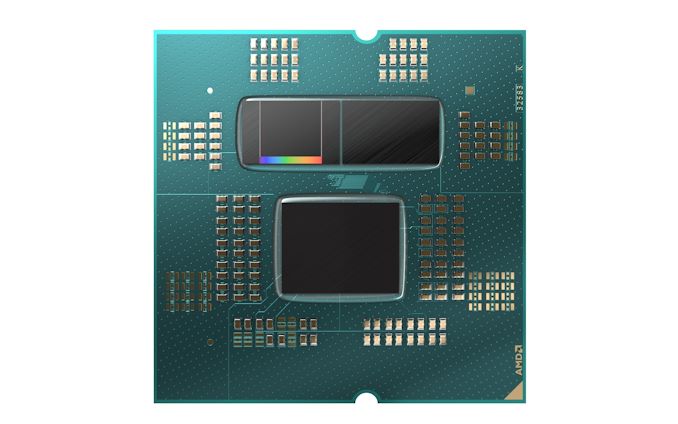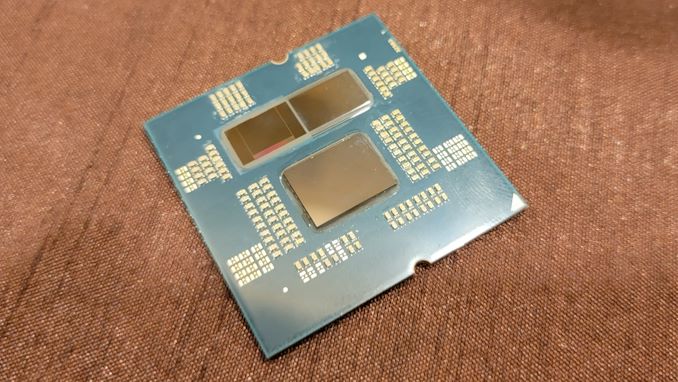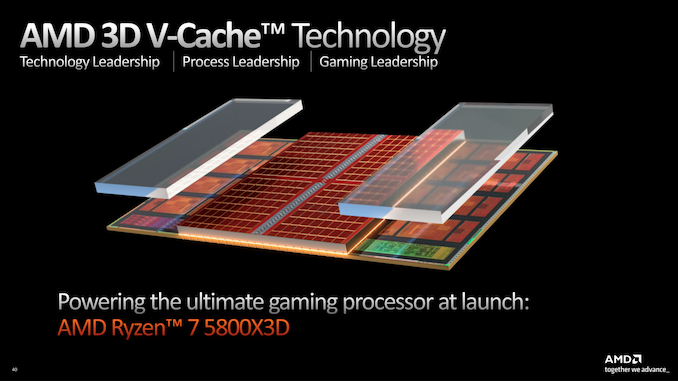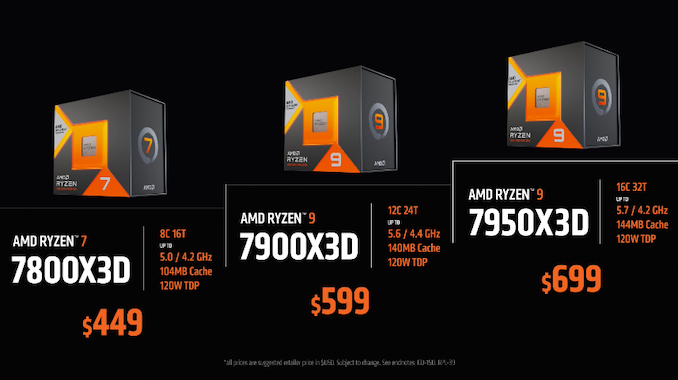AMD’s Ryzen 7000X3D Chips Get Release Dates: February 28th and April 6th, For $699/$599/$449
by Ryan Smith on February 1, 2023 9:45 PM EST- Posted in
- CPUs
- AMD
- X3D
- Ryzen 7000
- Raphael
- 3D V-Cache

AMD today has announced the launch date and prices for its eagerly anticipated Ryzen 7000X3D series processors. Aimed primarily at gamers, the company’s first L3 V-Cache equipped Ryzen 7000 processors will begin rolling out on February 28th, when the Ryzen 9 7950X3D and Ryzen 9 7900X3D go on sale for $699 and $599 respectively. This will be followed up by the Ryzen 7 7800X3D a bit over a month later, when it goes on sale for $449 on April 6th.
First announced to great fanfare during AMD’s CES 2023 keynote (and teased well before that), the Ryzen 7000X3D chips will be AMD’s second generation of consumer chips employing the company’s novel 3D stacked V-Cache technology. V-Cache allows AMD to stack a 64MB L3 cache die on top of their existing CCDs in order to expand the total L3 capacity of a Zen 3/4 CCD, going from 32MB to 96MB. And in the case of multi-CCD designs such as the Ryzen 9 7950X, bringing the total, chip-wide L3 cache pool to 128MB.
| AMD Ryzen 7000X/X3D Series Line-Up | |||||||
| AnandTech | Cores Threads |
Base Freq |
Turbo Freq |
L3 Cache |
TDP | Price (Street) |
Release Date |
| Ryzen 9 7950X3D | 16C / 32T | 4.2 GHz | 5.7 GHz | 128 MB | 120W | $699 | 02/28/23 |
| Ryzen 9 7950X | 16C / 32T | 4.5 GHz | 5.7 GHz | 64 MB | 170W | $583 | - |
| Ryzen 9 7900X3D | 12C / 24T | 4.4 GHz | 5.6 GHz | 128 MB | 120W | $599 | 02/28/23 |
| Ryzen 9 7900X | 12C / 24T | 4.7 GHz | 5.6 GHz | 64 MB | 170W | $444 | - |
| Ryzen 7 7800X3D | 8C / 16T | 4.2 GHz | 5.0 GHz | 96 MB | 120W | $449 | 04/06/23 |
| Ryzen 7 7700X | 8C / 16T | 4.5 GHz | 5.4 GHz | 32 MB | 105W | $299 | - |
| Ryzen 7 5800X3D | 8C / 16T | 3.4 GHz | 4.5 GHz | 96 MB | 105W | $323 | - |
Following the successful trial of the technology in the consumer space with AMD’s original Ryzen 7 5800X3D, which was released to positive acclaim back in the spring of 2022, AMD has developed a much broader lineup of V-Cache equipped Ryzen chips for this generation. This includes not only the 5800X3D’s direct successor, the 8 core Ryzen 7 7800X3D, but also, for the first time, chips employing multiple CCDs. These are the Ryzen 9 7900X3D and 7950X3D, which will offer 12 and 16 CPU cores, respectively.
Interestingly, AMD has gone for a non-homogenous design for these multi-CCD parts – rather than giving both CCDs V-Cache, AMD is only outfitting one of the CCDs with the extra L3 cache. The other CCD will remain a plain Zen 4 CCD, with its integrated 32MB of L3 cache. The unbalanced design, besides allowing AMD to control the costs of what’s still a relatively expensive technology to implement, will allow AMD to offer something close to the best of both worlds for their multi-CCD parts. The V-Cache equipped Zen 4 CCDs will offer 6 or 8 CPU cores backed by the massive L3 pool, for tasks that benefit from the larger cache size, while the vanilla Zen 4 CCDs will be unencumbered by the V-Cache, allowing them to clock higher for pure throughput workloads that wouldn’t benefit from the extra cache.
As with the original 5800X3D, AMD is aiming these chips at gamers in particular, as the complex, heavy-dataset nature of video games means they often benefit from having additional L3 cache on-hand. The 5800X3D was, depending on the game, around 15% faster than its vanilla Ryzen counterpart – at least so long as it wasn’t GPU limited. AMD is being a bit more coy this time around on making apples-to-apples comparisons against their regular Ryzen 7000 chips, so for now the only official performance figures available from AMD are pitting the chips against the 5800X3D. In lieu of that, a 15% improvement is a reasonable baseline given that the cache sizes haven’t changed in the last generation, but we’ll definitely want to take a closer look at the final chips to see if the additional L3 cache is as beneficial to Zen 4 as it was for Zen 3.
Back at their CES 2023 keynote, AMD announced the specifications for two-and-a-half of the chips, as well as an undetailed February launch date. With today’s announcement, AMD is finally filling in the rest of the details, as well as confirming that only part of the product stack is going to make that February launch date.

(Image Courtesy Tom's Hardware)
As previously noted, the Ryzen 9 7950X3D and Ryzen 9 7900X3D both launch on February 28th. The 16 core 7950X3D will hit the streets with a $699 price tag, while the 12 core 7900X3D will intro at $599. At current street prices, this represents roughly a $100 to $150 premium over the chips’ regular counterparts, with the 7950X selling for around $583, and the 7900X selling for around $444. Prices on AMD’s top AM5 chips have come down a decent bit since their 2022 launch, so the new X3D SKUs are coming in at similar launch prices as their non V-Cache counterparts. Put another way, whereas $699 would get you a 16 core 7950X in September, come February it will get you the same chip with an additional 64MB of L3 cache.
Other than benchmarks, at this point the only detail we don’t have on the 7950X3D and 7900X3D are the clockspeeds for the V-Cache equipped CCDs. AMD’s quoted turbo clockspeeds are for the vanilla CCD, so it’s unclear just how much clockspeeds have been lowered for the V-Cache CCD. But taking a hint from AMD’s sole single CCD X3D part, the 7800X3D, we see that part has a top clockspeed of just 5.0GHz. So we’d expect something similar for the V-Cache CCDs on the Ryzen 9 parts.
Speaking of the Ryzen 7 7800X3D, we finally have the full specifications on AMD’s most straightforward X3D part. Back in January AMD hadn’t locked down the base clockspeeds on this part, but as of today we finally have the answer: 4.2GHz. The chip will, in turn, be able to turbo as high as 5.0GHz as previously noted.
The cheapest of the Z3D parts, with a price tag of $449, the 7800X3D will also be the laggard of the group, with the chip not launching until April 6th. AMD has not explained the gap in launch dates, but it’s reasonable to assume that AMD is prioritizing the assembly and shipping of their more expensive Ryzen 9 SKUs. In any case, at current street prices the 7800X3D will carry a $150 premium over the $299 7700X, making it a full 50% more expensive, assuming these street prices hold through April. This happens to be the same price the 5800X3D launched at, so AMD is technically just holding the line here, but it does underscore how price cuts on the rest of the Ryzen 7000 lineup have made the standard chips very competitive on a price/performance basis.
In any case, we’ll have more on AMD’s first V-Cache equipped Zen 4 chips later this month. Besides taking an in-depth look at the performance improvements brought about by the larger L3 cache, the other major factor driving performance is going to be the Windows thread scheduler. As this is AMD’s first asymmetric Ryzen CPU, it will be up to Windows and AMD’s chipset driver to figure out which CCD to place threads on for the 7950X3D/7900X3D. So this month’s launch is going to require that AMD’s hardware and software offerings are in sync in order for the company to make a good first impression.












64 Comments
View All Comments
Bruzzone - Tuesday, February 7, 2023 - link
I think you r correct, 7900X3D is 8 + 4 so the non hybrid bounded quad like its octa sibling is tuned for frequency. I question hexa can be relied for hybrid bonding L3 add on the pad placement. mbSamus - Thursday, February 2, 2023 - link
Hella money, but pretty insane to have 128MB+ on-die cache in a consumer CPU.nandnandnand - Thursday, February 2, 2023 - link
The best you're getting is still 96 MB per core.Intel did have 128 MB of eDRAM on some Haswell through Coffee Lake chips, although it was a lot slower than 3D V-Cache.
https://www.anandtech.com/show/16195/a-broadwell-r...
It would be nice to see big L4 on consumer CPUs again in the future.
Samus - Thursday, February 2, 2023 - link
The 5775C cache was external of the CPU die, not stacked, kind of a glorified external cache on a package vs a PCB (ala Pentium 2)And as you mentioned, whether directed at your eDRAM\Haswell statement or not, it was technically L4 and a victim cache in the hierarchy. Who knows maybe it inspiredAMD to do what they did here but Intel killed it because manufacturing just wasn't ready to make it worthwhile...for the price.
geniekid - Thursday, February 2, 2023 - link
Indeed. The 5800X3D reminds me a lot of the 5775C where specific workloads would gain such a large performance boost that the chip continued to be competitive in overall benchmarks across multiple generations.I do wonder how a modern "L4" implementation might compare against stacked L3. Surely there would be trade-offs worth considering between speed/latency and size/thermals/power.considering.
brucethemoose - Thursday, February 2, 2023 - link
We will get to see with sapphire rapids, which can use the HBM as L4 cache.brucethemoose - Thursday, February 2, 2023 - link
TBH Intel killed it because the only OEM who wanted IGP performance was Apple.Bruzzone - Tuesday, February 7, 2023 - link
Broadwell 5775C one of the most costly Core line products Intel every made. mbabufrejoval - Monday, February 20, 2023 - link
I have a NUC8 like that, 48EU iGPU with the 128MB eDRAM chip and a NUC11 with the 96EU iGPU that doesn't have the eDRAM chip. Both run DDR4-3200. And I also have a NUC10 with the normal 24EU iGPU, no extra eDRAM and DDR4-3200 as well (in sticks, it might actually operate slightly slower).The theory behind the eDRAM chip was that it would enable the iGPU to scale whilst DRAM bandwidth was the main obstacle to benefit from additional iGPU cores.
And it was quite obvious, that the eDRAM wasn't nearly as effective as it should as the 48EU iGPU only delievered around "32EU" worth of performance, 50% more iGPU power than the 24EU baseline. So even if the eDRAM enhanced was designed for Apple, Apple evidently wasn't very happy with the power they got.
So when the Tiger Lake came out with 96EU and zero eDRAM, I was actually expecting to be quite disappointed because the DRAM bandwidth hadn't really improved by much: the value differences reported by GPU-Z for all three variants were really minor.
But the 96EU iGPU did deliver almost exactly 4x the performance of the 24EU baseline, which was never well researched or explained by anyone in the press. My only explanation would be that an internal cache was now acting as a scratchpad for all sorts of texture operations and that thus it was able to make do without using invisible parts of the frame buffer to run shader operations at full speed of the EUs.
It still couldn't convert the current 96EU iGPUs into speed monsters that could rival a dGPU, but in it's niche it was pretty impressive.
Outside graphics, I didn't notice any significant benefits from the eDRAM. Playing NUC10 cores (no eDRAM) and NUC8 cores (128MB eDRAM) against each other in scalar workloads, the NUC10 always came ahead ever so slightly, because it had 200MHz more clock. IPC was pretty mucn unchanged between those two, while the 4 Tiger Lake cores performed pretty exactly the same as the 6 Cannon Lake cores on multi-threaded workloads.
Very long story short: I don't believe you'll see any benefit from an L4 on any software you actually run. It would take a tailor made synthetic workload to eke out any benefit, nothing quite on par with the the iGPUs could do with it. And even those struggled...
Cooe - Thursday, February 2, 2023 - link
The only real downside of AMD's asymmetric approach to the multi-CCD Ryzen 7000X3D parts is that they will require OS side optimizations to thread scheduling to work correctly (although these are relatively easy enough changes to make, as it's BLATANTLY APPARENT to the OS how cache/memory heavy a given process is, and even how often its cache accesses are hitting vs missing [indicating a need for more/less L3]), meaning they will be limited in terms of operating system selection to prolly just Windows 11 & anything using the Linux kernel. 🤷Otherwise it's basically ALL win, as a real "Have your cake and eat it too!" kinda genius lightbulb moment on AMD's part!